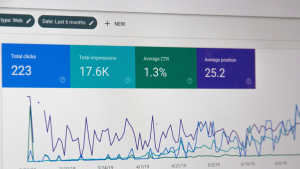What is SEO?
SEO (Search Engine Optimization) is the practice of optimizing a website or online content to improve its ranking and visibility in search engines like Google, Bing, etc. The goal of SEO is to increase organic traffic to a website by making it more search engine friendly and improving its relevance to specific keywords or phrases. This includes techniques like keyword research, on-page optimization, backlink building, and technical SEO to ensure that the website is optimized for search engines and users alike.
How does SEO work?
SEO works by improving the visibility and ranking of a website in search engine results pages (SERPs) for specific keywords or phrases. Search engines use algorithms to crawl, index, and understand the content on the web and rank the pages based on relevance and authority.
Relevance refers to how well the website or page matches the user’s search query, while authority refers to the credibility and trustworthiness of the website.
To improve a website’s visibility and ranking, SEO practitioners follow best practices and techniques like:
- Keyword research: Identifying keywords that potential customers might use to search for products or services similar to what the website offers.
- On-page optimization: Making sure that the website’s content and structure are optimized for both users and search engines, using the keywords identified in keyword research.
- Backlink building: Acquiring high-quality, relevant links from other reputable websites to improve the authority and credibility of the site.
- Technical SEO: Ensuring that the website has a clean and efficient code, a fast loading speed, a mobile-friendly design, and proper tracking and monitoring.
By following these and other SEO best practices, a website can improve its ranking and visibility in search results, attracting more organic traffic, and increasing its online visibility and credibility.

Types:
There are two main types of SEO:
1.On-page SEO
2.Off-page SEO
- On-page SEO refers to optimizing individual pages on a website in order to rank higher and earn more relevant traffic in search engines. On-page SEO includes optimizing the content, meta tags, images, and internal links on a page.
- Off-page SEO refers to optimizing the backlink profile of a website. This involves acquiring high-quality, relevant backlinks from other reputable websites, which help to increase the website’s credibility and authority in the eyes of search engines. Off-page SEO also includes link building, which involves actively seeking out new backlink opportunities.
Additionally, there is also a third type of SEO, known as technical SEO, which involves optimizing the technical elements of a website to make it more search engine friendly. This includes elements like website speed, mobile-friendliness, and crawlability.
By focusing on both on-page and off-page SEO, as well as technical SEO, website owners can improve their website’s visibility and ranking in search engine results pages, and attract more organic traffic.
SEO Tools:
There are many tools available to help with SEO. Here are some of the most popular SEO tools:
- Google Search Console: A free tool that allows website owners to monitor their website’s performance on Google and track important metrics like search traffic, crawl errors, and backlink profiles.
- Google Analytics: A free tool that tracks website traffic and provides detailed information about the behavior of website visitors.
- Ahrefs: A paid tool that provides in-depth analysis of a website’s backlink profile, including the quantity, quality, and authority of links pointing to the site.
- SEMrush: A paid all-in-one marketing tool that offers keyword research, site audit, and competitor analysis features, among others.
- Moz Pro: A paid all-in-one SEO tool that offers keyword research, site audit, link building, and ranking tracking features.
- Screaming Frog: A paid tool that crawls websites and provides in-depth information about the site structure, content, and technical SEO elements.
- Keyword Planner: A free tool within Google Ads that helps identify keyword ideas and estimate their search volume and competition.
These are just a few examples of the many SEO tools available. The best tool or combination of tools depends on the needs and goals of the website owner.

How to Learn SEO:
Learning SEO can be done through a combination of the following methods:
- Online Resources: There is a wealth of information available online about SEO, including articles, tutorials, blog posts, and online courses. Websites like Moz, Search Engine Land, and Backlinks are great resources to start with.
- Books: There are many books available on SEO, including beginner-friendly guides, as well as more advanced, technical books.
- Online Courses: Platforms like Udemy, Coursera, and LinkedIn Learning offer online courses on SEO, which can provide a structured learning experience and help you learn at your own pace.
- Practice: One of the best ways to learn SEO is by doing it. Start with optimizing your own website, or volunteer to help optimize websites for friends, family, or non-profits.
- Attend Conferences and Workshops: Attending SEO conferences and workshops can provide opportunities to learn from experts in the field, network with other SEO professionals, and stay up-to-date with the latest trends and best practices.
Regardless of which learning method you choose, it’s important to stay up-to-date with the latest trends and best practices in SEO, as the field is constantly evolving.
Importance of SEO in Marketing:
SEO is an important component of digital marketing and has the following benefits:
- Increased Visibility: SEO helps improve the visibility and ranking of a website in search engine results pages (SERPs), making it easier for potential customers to find the website when searching for products or services related to the business.
- Increased Traffic: By improving visibility and ranking, SEO can increase the amount of organic traffic a website receives, leading to more leads, sales, and revenue.
- Cost-effective: Unlike traditional marketing methods like print, radio, and television advertising, SEO is a cost-effective way to reach potential customers. Once a website is optimized, it will continue to receive organic traffic, making it a long-term investment.
- Measurable Results: SEO allows for detailed tracking and measurement of a website’s performance and success, making it easier to adjust and optimize the strategy as needed.
- Improved User Experience: Good SEO practices like fast website speed, easy navigation, and mobile-friendliness also improve the overall user experience for website visitors, leading to a higher likelihood of conversion.

By incorporating SEO into their overall marketing strategy, businesses can improve their online visibility, attract more organic traffic, and achieve better ROI. It is an important aspect of a comprehensive digital marketing plan.
In conclusion, SEO (Search Engine Optimization) is a crucial aspect of digital marketing that helps improve the visibility and ranking of a website in search engine results pages (SERPs). By using various optimization techniques, website owners can improve their website’s ranking for relevant keywords, attract more organic traffic, and ultimately drive better business results.
SEO involves optimizing both on-page and off-page elements, such as keywords, meta tags, content quality, and link building, to meet search engine algorithms and ranking criteria. It is important to stay up-to-date with the latest trends and best practices in SEO, as search engines like Google constantly update their algorithms to provide the best user experience.
To learn SEO, there are many resources available, including online articles and tutorials, books, online courses, and attending conferences and workshops. With consistent effort and a strategic approach, anyone can learn and implement effective SEO practices to improve their website’s performance and reach their target audience.





